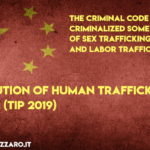
As reported over the past five years, human traffickers exploit foreign victims in Italy. Victims originate primarily from Nigeria and other African countries, China, and Eastern Europe. Italy has an estimated 1.5 million unregistered workers, who were particularly vulnerable to labor trafficking. Labor traffickers operate in agriculture, predominantly in southern Italy, and in construction, household labor, hospitality, and restaurants mainly in the north. Textile factories exploit Chinese and other victims in Milan, Prato, Rome, and Naples. Chinese criminal elements force victims to work in apartments and in massage parlors.
Approximately 80 percent of trafficking victims are from Nigeria. International organizations estimated up to 75 percent of the Nigerian women and unaccompanied children who arrived in 2018 were trafficking victims. Nigerians represented nearly 36 percent of the victims who received residency permits in 2018, primarily women and girls subjected to sex trafficking through debt-based coercion and many coerced through voodoo rituals. Several Nigerian trafficking networks have expanded operations across Italy and reportedly receive protection from Italian crime syndicates. Of an estimated 40,000 to 45,000 individuals in prostitution on the streets, NGOs reported approximately 60 percent are trafficking victims or vulnerable to trafficking; the majority come from Nigeria or Romania, and between five and eight percent are minors.
Italy has accommodated more than 700,000 seaborne migrants since 2011, although the rate dropped precipitously in 2018, due in part to government policy tightening the intake of irregular migrants and the government’s assistance to the Libyan Coast Guard. Italy received 23,370 irregular arrivals by sea in 2018 and just more than half (12,977) via Libya, where many reported experiencing extortion, torture, and rape by militias or traffickers while awaiting passage. Traffickers frequently target unaccompanied children, including boys forced to work in shops, bars, restaurants, bakeries, or in forced begging. Of the 61,000 persons requesting asylum in 2018, authorities estimate up to 30 percent are vulnerable to sex or labor trafficking while waiting for adjudication of their petition.
According to the government, 3,534 unaccompanied children arrived in 2018, mostly boys and the majority from Africa, a significant decline from 15,731 arriving in 2017 and 25,846 in 2016. Asylum-seekers may legally work beginning two months after filing their application, although many seek illegal employment immediately in informal sectors, increasing their vulnerability to trafficking. Many also attempt passage to other European countries. However, under the European Commission’s Dublin Regulation, countries may repatriate victims to the EU country of their arrival. This regulation likely increased the number of asylum seekers or trafficking victims now forced to remain in Italy, or return to Italy from another EU country.
Adapted from TIP 2019 by the U.S. Department of State

